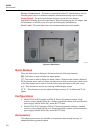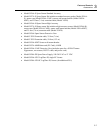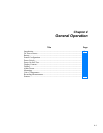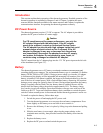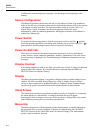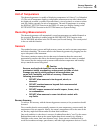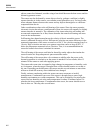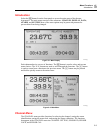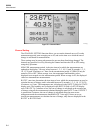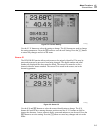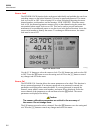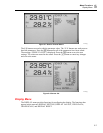
5020A
Users Manual
4-6
objects cannot be eliminated, consider using a heat shield between the heat source and the
thermo-hygrometer sensor.
The sensor can also be heated by warm objects close by, perhaps a wall that is slightly
warmer than the air in the room or even another sensor placed next to it. For best results,
allow adequate distance between the sensor and any objects that might be at a different
temperature than the air.
Other considerations relate to the self-heating of the sensor. Since the sensor contains
electronic circuits that release a small amount of heat, the sensor will naturally be slightly
warmer than the air around it. The calibration of the sensor takes this self-heating into
account and compensates for it. But, factors that alter the natural self-heating can cause
errors in the measurement.
Self-heating does depend somewhat on the velocity of the air around the sensor. The
sensor is calibrated in nearly still air. Different air velocities can cause differences in the
measured temperature of the sensor: as much as ±0.06 °C for velocities ranging from 0 to
10 cm/s. High velocities can cause even greater errors that can be as large as 0.15 °C
below the temperature measured at low velocities. Thus, it is recommended that the
sensor be located where there is minimal air currents.
The self-heating of the sensor could also be altered by nearby objects that insulate the
sensor from the air. Keep adequate air space around the sensor.
The self-heating of the sensor takes a few minutes to stabilize after the power to the
thermo-hygrometer is switched on or the sensor is attached. For best results, allow 15
minutes for the sensor to settle after applying power.
The sensor takes some time to respond to large changes in temperature or humidity, such
as, for instance, when the sensor is brought from a cold or humid location to a warm or
dry one. Depending on the difference, the sensor can take several minutes to more than
an hour to reach full accuracy after conditions have changed.
Finally, moisture condensing within the sensor can cause erroneous or invalid
measurements. Condensation can occur if the sensor is brought from a warm, high-
humidity environment to a colder temperature. This can be avoided by first moving the
sensor into low-humidity air at the same temperature for about 30 minutes before it is
placed at the lower temperature. If condensation does occur, the sensor should recover
once it dries out. This may take several hours.



